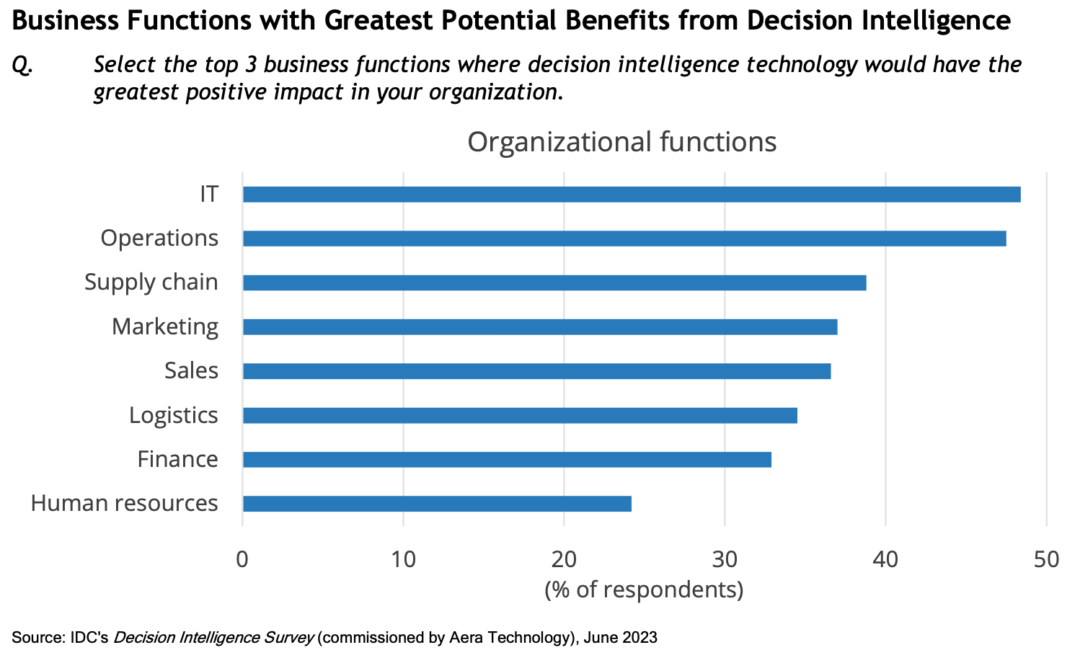IDC: businesses achieve faster “decision velocity” through AI
Study cites CPG company that sends its employees AI-generated recommendations based on data analysis and pre-set rules

Companies that are leading the charge to apply artificial intelligence (AI) to their business decision-making processes share a common set of attributes, according to an IDC white paper commissioned by Aera Technology.
What unites these pioneering organizations that have adopted “decision intelligence” are clear goals and KPIs by which to measure progress, active investment in technology to accelerate decision velocity, and a pragmatic use of AI, analytics, and data technologies and skills, IDC said.
As a result, those organizations are achieving greater “decision velocity” while competing in an environment of heightened volatility, uncertainty, complexity, and ambiguity, according to the report, “What Every Executive Needs to Know About AI-Powered Decision Intelligence.” The paper was based on a study of business and IT decision makers from 322 large companies across eight countries and six industries.
As an example, the paper cited an unnamed consumer packaged goods (CPG) company that has been helping its employees make decisions by sending them AI-generated, data-driven recommendations. The company’s “decision intelligence technology” also makes certain automated decisions that are determined automatically by the software based on data analysis and pre-defined business rules.
That CPG company, which has over 400 brands and operations in 180 countries, has been on a multiyear AI adoption journey focused on the goal of creating an end-to-end, "self-driving" automated supply chain. Its goal is to intelligently automate a set of decisions — changing the decision-making process from one that relies only on human intuition, siloed data, and the inertia of past experiences to one that incorporates AI-powered decision-making capabilities that assist or augment the human decision maker, and may eventually automate all of a set of selected decisions.
“IDC’s research clearly shows the value creation divide among enterprises operationalizing decision intelligence and those that are not,” Fred Laluyaux, CEO of Aera Technology, said in a release. “The next wave of enterprise digital transformation can no longer be another data lake or planning tool. People must be empowered with innovative, intuitive technology that accelerates accurate decision making at scale and enables companies to be self-driving, self-learning, and ready to compete in a digital world.”
That approach would represent a large change from the current model, IDC said. In response to the question "Of all the decisions you make in your usual flow of work, what percentage are made in the following ways?" researchers found that on average:
▪ one-third of decisions are made based primarily on experience or intuition, with minimal reliance on data analysis,
▪ one-third of decisions are made based primarily on deliberate data analysis, including evaluation of alternatives and understanding of potential outcomes and their impacts, and
▪ one-third of decisions are made based on a well-balanced combination of experience and data-driven decision making.
The survey also examined how AI-powered decision making would have the greatest impact to an organization. Survey participants ranked their top eight options as follows: IT (48.4%), operations (47.5%), supply chain (38.8%), marketing (37%), sales (36.6%), logistics (34.5%), finance (32.9%), and HR (24.2%).
Related Articles

Copyright ©2024. All Rights ReservedDesign, CMS, Hosting & Web Development :: ePublishing